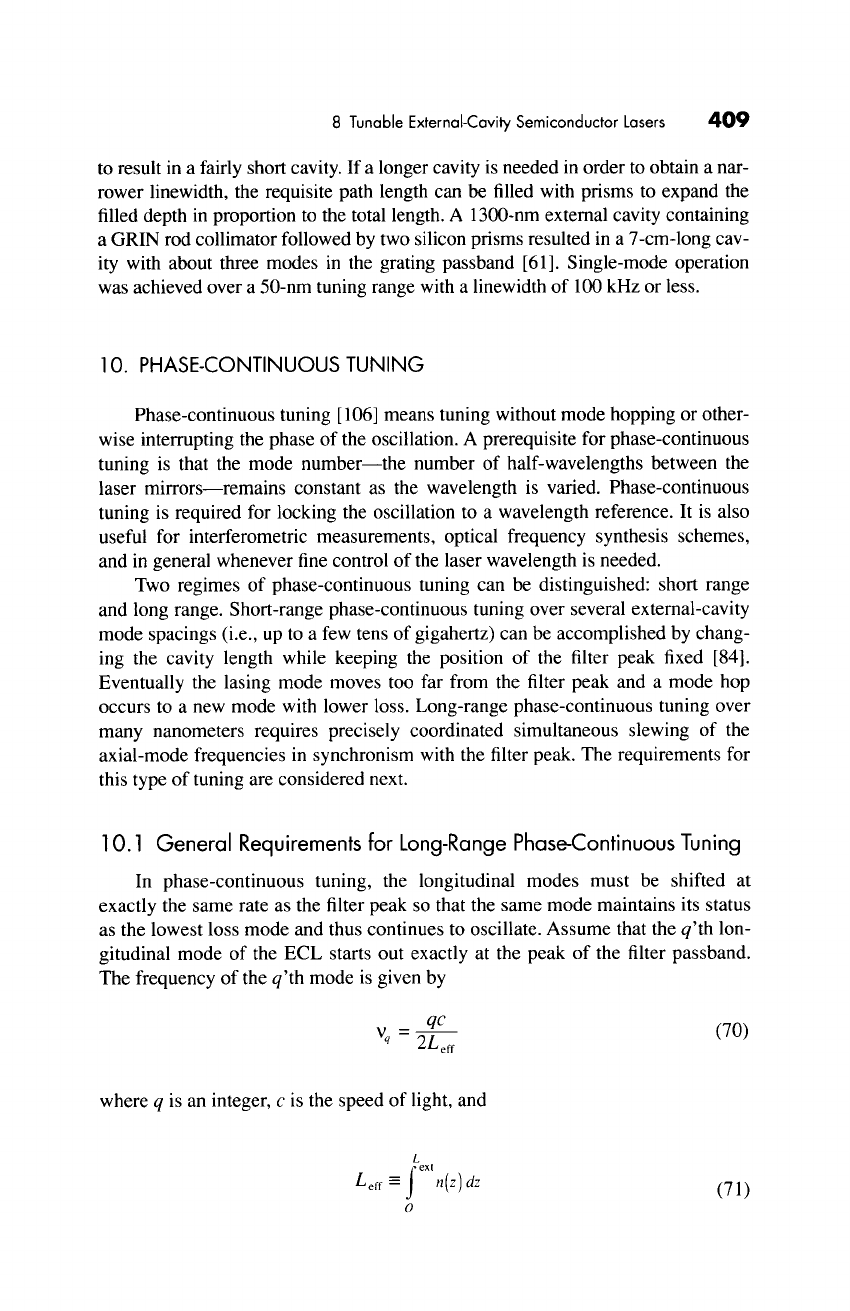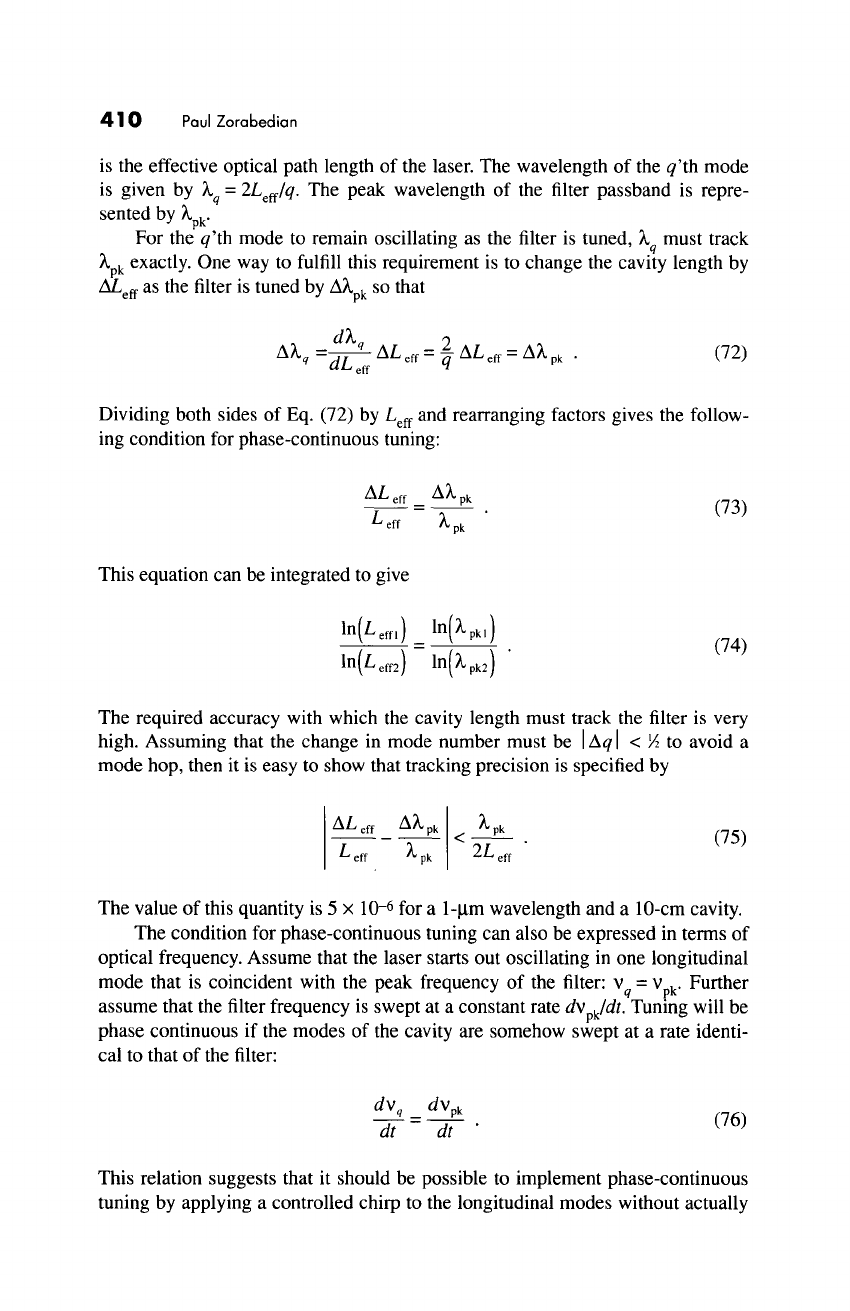
8 Tunable External-Cavity Semiconductor Lasers 409
to result in a fairly short cavity. If a longer cavity is needed in order to obtain a nar-
rower linewidth, the requisite path length can be filled with prisms to expand the
filled depth in proportion to the total length. A 1300-nm external cavity containing
a GRIN rod collimator followed by two silicon prisms resulted in a 7-cm-long cav-
ity with about three modes in the grating passband [61]. Single-mode operation
was achieved over a 50-nm tuning range with a linewidth of 100 kHz or less.
10. PHASE-CONTINUOUS TUNING
Phase-continuous tuning [ 106] means tuning without mode hopping or other-
wise interrupting the phase of the oscillation. A prerequisite for phase-continuous
tuning is that the mode numbermthe number of half-wavelengths between the
laser mirrorsmremains constant as the wavelength is varied. Phase-continuous
tuning is required for locking the oscillation to a wavelength reference. It is also
useful for interferometric measurements, optical frequency synthesis schemes,
and in general whenever fine control of the laser wavelength is needed.
Two regimes of phase-continuous tuning can be distinguished: short range
and long range. Short-range phase-continuous tuning over several external-cavity
mode spacings (i.e., up to a few tens of gigahertz) can be accomplished by chang-
ing the cavity length while keeping the position of the filter peak fixed [84].
Eventually the lasing mode moves too far from the filter peak and a mode hop
occurs to a new mode with lower loss. Long-range phase-continuous tuning over
many nanometers requires precisely coordinated simultaneous slewing of the
axial-mode frequencies in synchronism with the filter peak. The requirements for
this type of tuning are considered next.
10.1 General Requirements for Long-Range Phase-Continuous Tuning
In phase-continuous tuning, the longitudinal modes must be shifted at
exactly the same rate as the filter peak so that the same mode maintains its status
as the lowest loss mode and thus continues to oscillate. Assume that the q'th lon-
gitudinal mode of the ECL starts out exactly at the peak of the filter passband.
The frequency of the q'th mode is given by
qc
(70)
Vq - 2Lef f
where q is an integer, c is the speed of light, and
L
f
ext
= .(zldz
0
(71)

410 Paul Zorabedian
is the effective optical path length of the laser. The wavelength of the q'th mode
is given by
~q =
2Leff/q.
The peak wavelength of the filter passband is repre-
sented by ~'pk"
For the q'th mode to remain oscillating as the filter is tuned,
~q must
track
~'pk exactly. One way to fulfill this requirement is to change the cavity length by
z~.,eff as the filter is tuned by A~,pk so that
d~q AL
eff -" 2 AL eff -" m~ pk 9
A~q
=dL
eff
(72)
Dividing both sides of Eq. (72) by Lef t and rearranging factors gives the follow-
ing condition for phase-continuous tuning:
AL eff -- A)bpk
(73)
L eff ~'pk "
This equation can be integrated to give
m
"
(74)
The required accuracy with which the cavity length must track the filter is very
high. Assuming that the change in mode number must be
I Aql < ~ to
avoid a
mode hop, then it is easy to show that tracking precision is specified by
AL eft A~, pk
L
eft ~ pk
pk
< . (75)
2L
eff
The value of this quantity is 5 x 10 -6 for a 1-ktm wavelength and a 10-cm cavity.
The condition for phase-continuous tuning can also be expressed in terms of
optical frequency. Assume that the laser starts out oscillating in one longitudinal
mode that is coincident with the peak frequency of the filter: V q = V pk. Further
assume that the filter frequency is swept at a constant rate dVpk/dt. Tuning will be
phase continuous if the modes of the cavity are somehow swept at a rate identi-
cal to that of the filter:
dVq
dVpk
d--i -= dt "
(76)
This relation suggests that it should be possible to implement phase-continuous
tuning by applying a controlled chirp to the longitudinal modes without actually
Get Tunable Lasers Handbook now with the O’Reilly learning platform.
O’Reilly members experience books, live events, courses curated by job role, and more from O’Reilly and nearly 200 top publishers.

